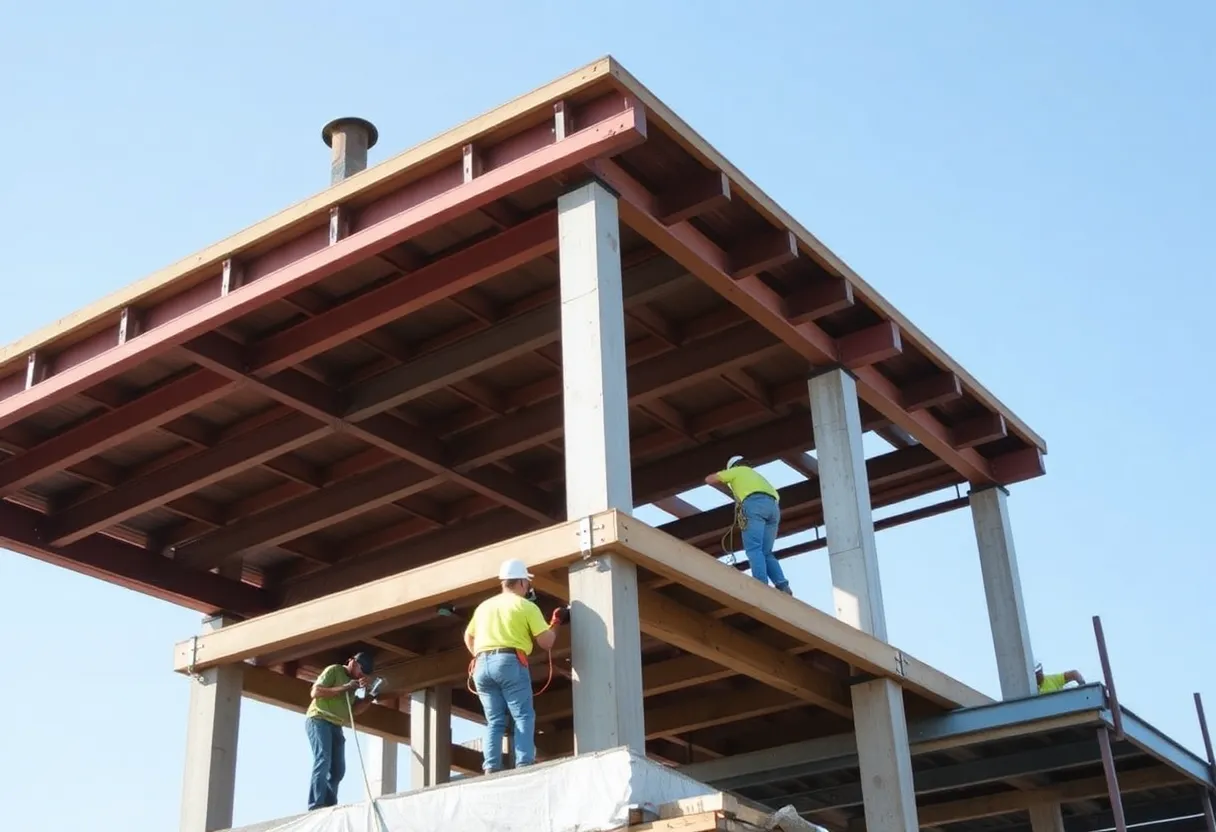Dublin, Ireland, October 14, 2025
News Summary
A new market study finds the global construction design software market is expanding rapidly, driven by adoption of BIM, cloud collaboration, AI-powered generative design and digital twin technologies. Firms increasingly use design tools for 2D drafting, 3D modeling, structural analysis, clash detection and real-time stakeholder collaboration, improving accuracy and reducing rework. Demand spans developed and emerging markets, supported by modular construction, public BIM mandates, and integration with construction management and ERP systems. SaaS licensing, strategic vendor partnerships, and M&A activity are accelerating innovation and lowering barriers for small and mid-sized firms.
Construction design software market set to climb from US$9.9B (2024) to US$15.4B by 2030
A new market study finds the global market for Construction Design Software was estimated at US$9.9 billion in 2024 and is projected to reach US$15.4 billion by 2030, reflecting a forecasted compound annual growth rate of 7.7% from 2024 to 2030. The study was published as the report title: Construction Design Software – Global Strategic Business Report. The ResearchAndMarkets report provides an in‑depth analysis of market trends, drivers, and forecasts.
Why the market is expanding
Construction design software has become a cornerstone of modern architecture, engineering, and construction workflows. Digital design tools streamline workflows, enhance project accuracy, and reduce the cost and time associated with manual design revisions and on‑site changes. The shift from conventional CAD to advanced BIM systems has redefined design approaches in large‑scale residential, commercial, and infrastructure development projects.
Core capabilities driving adoption
The report highlights that construction design software enables 2D drafting, 3D modeling, Building Information Modeling (BIM), structural analysis, and real‑time collaboration among stakeholders. Construction firms use design software to simulate construction sequencing, simulate energy performance, and perform clash detection. Simulation and analysis capabilities in design software help mitigate risks before physical work begins.
Technology trends powering growth
Innovations in cloud computing, artificial intelligence, and digital twin technologies are rapidly advancing construction design software functionality. Cloud‑based platforms allow for real‑time data sharing and team collaboration, enabling multiple stakeholders (architects, engineers, contractors, clients) to work simultaneously on a single project model regardless of location. AI integration supports generative design, which uses algorithms to suggest multiple design outcomes based on constraints. Digital twin technology creates a real‑time digital representation of a physical building or infrastructure asset and is being incorporated into BIM platforms to facilitate lifecycle management. Augmented reality and virtual reality tools enhance stakeholder engagement by enabling immersive walkthroughs and spatial planning reviews.
Market geography and segments
Demand for construction design software is growing in both mature and emerging markets. Developed economies cited as witnessing increased investments include the United States, United Kingdom, Germany, Japan, Australia, with investments tied to smart city development, retrofitting, and green building initiatives. Emerging markets cited include India, Indonesia, Vietnam, and several African nations, which are investing heavily in urbanization, transport infrastructure, and affordable housing. Expansion of modular and prefabricated construction is driving demand for precision design software that supports off‑site planning and factory‑based component fabrication.
Business models, vendors and ecosystems
The ResearchAndMarkets study profiles 34 companies and notes the emergence of Software‑as‑a‑Service models and modular licensing options that are lowering entry barriers for small and mid‑sized firms. Strategic partnerships between software developers, construction tech firms, and hardware providers such as 3D scanners and drones are creating ecosystems that streamline design‑to‑construction workflows. Design tools integrated with construction management software, ERP systems, and procurement platforms are increasingly valuable for end‑to‑end project planning. Software vendors are focusing on user experience, offering intuitive interfaces and automation features to reduce learning curves and improve productivity.
Regulatory and institutional drivers
Governments in regions such as North America, Europe, and Asia‑Pacific are mandating BIM usage for public infrastructure planning. BIM mandates reinforce the software’s role in achieving sustainability, cost transparency, and lifecycle asset management. Educational institutions and technical training centers are adopting construction design tools to prepare the next generation of engineers and architects.
Industry context: capacity, labor and digital adoption
The broader construction sector shows strong fundamentals. Construction spending crossed US$2 trillion and the sector recorded a 10% increase in nominal value added and a 12% increase in gross output in 2024. Employment reached 8.3 million in July 2024, surpassing a previous peak of 7.7 million from 2006, even as the sector faces persistent labor shortages. Between August 2023 and July 2024 the industry had an average of 382,000 job openings each month. Labor shortages are a predominant issue affecting both skilled and unskilled positions, with securing onsite labor identified as particularly challenging. Companies are exploring digital tools and AI to increase capacity and capabilities and to offset labor shortages.
Finance, deals and investment outlook
Mergers and acquisitions activity is an important growth strategy. Between August 2023 and July 2024 there were 528 completed M&A deals in the construction industry totaling more than US$38 billion, and 112 completed M&A deals by PE investors totaling more than US$14 billion. Public investments such as the Infrastructure Investment and Jobs Act, the Inflation Reduction Act, and the CHIPS and Science Act are expected to underpin manufacturing, energy, and data center construction, where rising demand for AI and advanced computing could drive new projects.
Report access and contact
The ResearchAndMarkets report includes sections on Key Insights, Scope of Study, Key Attributes, MARKET OVERVIEW, MARKET TRENDS & DRIVERS, and FOCUS ON SELECT PLAYERS. For more information about the ResearchAndMarkets report visit https://www.researchandmarkets.com/r/9iilhz. Contact for ResearchAndMarkets press: Laura Wood, Senior Press Manager, [email protected]. ResearchAndMarkets phone contacts: E.S.T office hours phone: 1‑917‑300‑0470; U.S./CAN toll‑free phone: 1‑800‑526‑8630; GMT office hours phone: +353‑1‑416‑8900.
© 2025 Business Wire, Inc.
FAQ
What is the current global market size for construction design software?
The global market for Construction Design Software was estimated at US$9.9 billion in 2024.
What is the projected market size by 2030?
The global market is projected to reach US$15.4 billion by 2030.
What is the forecast growth rate for the market?
The market is forecast to grow at a CAGR of 7.7% from 2024 to 2030.
What is the report that contains this analysis?
The report title: Construction Design Software – Global Strategic Business Report.
What capabilities does construction design software enable?
Construction design software enables 2D drafting, 3D modeling, Building Information Modeling (BIM), structural analysis, and real‑time collaboration among stakeholders.
How are governments influencing adoption?
Governments in regions such as North America, Europe, and Asia‑Pacific are mandating BIM usage for public infrastructure planning.
What are the key technology trends advancing the software?
Innovations in cloud computing, artificial intelligence (AI), and digital twin technologies are rapidly advancing construction design software functionality.
Where can I find more information about the ResearchAndMarkets report?
For more information about the ResearchAndMarkets report visit https://www.researchandmarkets.com/r/9iilhz.
Key features at a glance
| Feature | Detail |
|---|---|
| Report title | Construction Design Software – Global Strategic Business Report. |
| Market size (2024) | US$9.9 billion |
| Market projection (2030) | US$15.4 billion |
| Forecast CAGR | 7.7% from 2024 to 2030 |
| Core software capabilities | 2D drafting; 3D modeling; BIM; structural analysis; real‑time collaboration |
| Key technology drivers | Cloud computing; AI; digital twins; AR/VR; generative design |
| Regions cited | United States, United Kingdom, Germany, Japan, Australia; India, Indonesia, Vietnam, several African nations |
| Vendors profiled | 34 companies featured in the report |
| Report access | https://www.researchandmarkets.com/r/9iilhz |
| Press contact | Laura Wood, Senior Press Manager, [email protected] |
Deeper Dive: News & Info About This Topic
Additional Resources
- ResearchAndMarkets / Business Wire: Construction Design Software – Global Strategic Business Report
- Wikipedia: Building information modeling
- Precedence Research: Construction and Design Software Market
- Google Search: Construction design software market 2024 forecasts
- GlobeNewswire: Construction Estimating Software Market to Reach USD 4.72 Billion by 2032
- Google Scholar: Construction estimating software market
- G2 Learning Hub: Construction Statistics
- Encyclopedia Britannica: construction industry
- Deloitte Insights: Engineering & Construction Industry Outlook
- Google News: construction design software
Author: Construction FL News
The FLORIDA STAFF WRITER represents the experienced team at constructionflnews.com, your go-to source for actionable local news and information in Florida and beyond. Specializing in "news you can use," we cover essential topics like product reviews for personal and business needs, local business directories, politics, real estate trends, neighborhood insights, and state news affecting the area—with deep expertise drawn from years of dedicated reporting and strong community input, including local press releases and business updates. We deliver top reporting on high-value events such as the Florida Build Expo, major infrastructure projects, and advancements in construction technology showcases. Our coverage extends to key organizations like the Associated Builders and Contractors of Florida and the Florida Home Builders Association, plus leading businesses in construction and legal services that power the local economy such as CMiC Global and Shutts & Bowen LLP. As part of the broader network, including constructioncanews.com, constructionnynews.com, and constructiontxnews.com, we provide comprehensive, credible insights into the dynamic construction landscape across multiple states.





